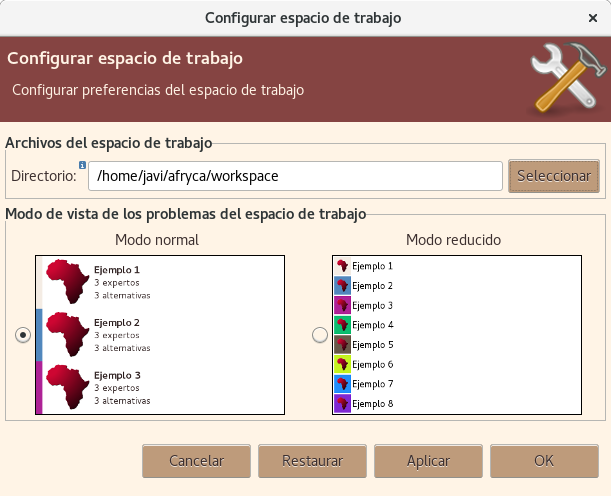Structure
In AFRYCA all elements of the application are stored in a directory called workspace. In this directory the application creates different folders in which store the created files. Specifically, in the workspace you can find the following directories:
- problems/: PTDG files.
- configurations/: Consensus model configurations.
- attitudes/: Conduct attitudes.
- scripts/: Files generated by ASE.
In turn, within the scripts directory are used different subdirectories for the storage of snippets, functions and links to modules. In this way, any PTDG created by the user will be stored in the <workspace>/problems/directory, the consensus model configurations in <workspace>/configurations/ and on the rest of the elements.
The elements generated by AFRYCA are internally stored using tagging of xml, although to facilitate their management each type of element is denoted with a different extension. You can find files with the following extensions:
- .afryca: PTDGs.
- .configuration: Consensus model configurations.
- .attitude: Conduct attitude.
- .script: Script files. Could be a snippet or a function.
- .category: Group of scripts. Could be a repository or a módule.
- .mb: Module link.
It should be noted that in the PTDGs, configurations and attitudes files, file names match the names of the element identifiers in the application, that is to say, if a PTDG is called 'x_problem', the physical file will be named ' Problem_x.afryca '. In files generated by ASE, to facilitate their invocation from the same environment allows the name of the file to be different than the identifier of the element.
Preferences
The workspace has support for preferences that allow customization. Specifically, from your preferences you can configure:
- Directory: Directory used for the workspace. By default, the workspace directory is set in the application directory. Supports the use of read-only directories. For more information, see the deployment section in the installation guide for linux or windows.
- Workspace Problems View Mode: It allows to change the type of visualization used in the problem view, being able to select a more detailed normal view or a more compact reduced view. By default it use the normal view.

Workspace Preferences
To modify the preferences of the workspace from AFRYCA, is offered a dialog box that can be opened by multiple ways:
- From the menu 'Edit > Preferences > Workspace'.
- From the menus of Problems, Configurations, Attitudes, Snippets o Functions views.
- Press the key combination 'Ctrl + P' as long as the selected view is one of the ones indicated in the previous point.
Native elements
AFRYCA supports the inclusion of preloaded or native elements, which are files integrated in the application libraries and on which the user can´t make modifications. These elements allow you to deploy AFRYCA with a defined set of elements that can be useful to the user.
The current version of AFRYCA includes several native elements such as:
- PTDGs used in previous publications in which the framework has been used.
- Modules, functions and links to modules used in the application.
- Mathematical libraries in snippet format developed from ASE.
- Repositories of ASE use example snippets.
To easily differentiated native elements from other elements of the workspace, a native element is marked with the letter 'N'.

Native elements